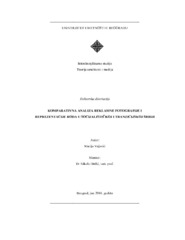| dc.contributor.advisor | Dedić, Nikola | |
| dc.contributor.other | Todić, Milanka | |
| dc.contributor.other | Šuica, Nikola | |
| dc.contributor.other | Šuvaković, Miodrag | |
| dc.contributor.other | Nikolić, Sanela | |
| dc.creator | Vujović, Marija | |
| dc.date.accessioned | 2016-07-14T13:52:10Z | |
| dc.date.available | 2016-07-14T13:52:10Z | |
| dc.date.issued | 2016-12-28 | |
| dc.date.submitted | 2016-07-14 | |
| dc.identifier.uri | http://eteze.arts.bg.ac.rs/handle/123456789/185 | |
| dc.description.abstract | Predmet istraživanja u doktorskoj disertaciji je vizuelna reprezentacija roda na
reklamnim fotografijama u proizvodima ženske popularne kulture, u ženskim časopisima.
Studija slučaja je ženski časopis sa najdužom tradicijom u Srbiji, Bazar, a socijalizam i
tranzicija posmatrani periodi. Postavljeni ciljevi i hipoteze jesu da su reklamne fotografije
tekstovi, značenjski vredni zapisi koje čitaoci ,,čitaju” i koji govore o raspodeli moći i
rodnim razlikama, a u skladu sa ideološkim konstruktima patrijarhalnog društva, i da su
nosioci rodnih stereotipa. Navedene hipoteze dokazujemo primenom kvantitativnokvalitativne
analize sadržaja objavljenih reklamnih fotografija u časopisu Bazar, u prvoj
polovini 1979. i 2014. godine. U radu se primenjuje i metodologija sociologa Ervinga
Gofmana (Erving Goffman), primenjena u knjizi Reklamiranje roda (Gender
Advertisements), koja predstavlja kombinaciju ramske i semiološke analize. Primenom
komparativne metode utvrđujemo da, uprkos promeni društveno-istorijskih okolnosti,
politika reprezentacije roda nije značajno promenjena u poslednjim decenijama. Pored
navedenih, primenjujemo i teorijsko-analitičke metode, kroz izbor i analizu
reprezentativnih tekstova iz oblasti semiologije, feminizma i studija kulture. Postavljeni
ciljevi i hipoteze u disertaciji su rezultatima istraživanja potvrđeni, a zaključak je da
reklamne fotografije imaju ulogu afirmacije vladajuće doktrine, vladajućih kulturnih
vrednosti, da ne ustaju protiv statusa quo u društvu. Masovni mediji održavaju mušku
dominaciju u patrijarhalnim društvima negujući rodne stereotipe. Na taj način mediji
produbljuju rodne nejednakosti, jer oni nisu samo ogledalo društvenih odnosa, već su u
sprezi sa vladajućom ideologijom, i njihov kreator. Medijski tekstovi aktivno i neprekidno
učestvuju u konstrukciji ,,ženskosti“ i ,,muškosti“ u jednom istorijskom trenutku. | sr |
| dc.description.abstract | Research subject in this PhD thesis is a visual representation of gender in
advertising photographs of women in the products of popular culture, in women's
magazines. The case study is a women's magazine with the longest tradition in Serbia,
Bazar, while socialism and the transition period will be observed. The set objectives and
hypotheses imply that the advertising photographs are actually textsand records of
importance which the readers “read”, and which talk about the distribution of power and
about gender differences, all in accordance with ideological constructs of patriarchal
society, and these are the source of gender stereotypes. These hypotheses will be proven
by using quantitative and qualitative analysis of the content of advertising photographs in
the magazine Bazar, in the first half of 1979 and 2014. The paper applies the methodology
used by the sociologist Erving Goffman, applied in the book Gender Advertisements,
which is a combination of frame and semiological analysis. By applying the comparative
method we determine that, despite the change of social and historical circumstances, the
policy of gender representation has not significantly changed in the last decades. In
addition to the aforementioned, we apply the theoretical and analytical methods for
selection and analysis of representative texts from the field of semiology, feminism and
cultural studies. The set objectives and hypotheses in this thesis have been confirmed
through research results, and the conclusion is that advertising photographs play the role
in affirmation of the predominant doctrine and of the predominant cultural values and they
do not stand up against the status quo in society. Mass media maintain male dominance in
patriarchal societies by cherishing gender stereotypes.In this way, the media deepen
gender inequalities because the media are not only the mirror of social relations, but they
are also in conjunction with the dominant ideology, and they are its creator. Media texts
actively and continuously participate in the construction of “femininity” and“masculinity”
in a certain historical period. | sr |
| dc.language.iso | srp | sr |
| dc.publisher | Универзитет уметности у Београду, Интердисциплинарне студије Универзитета уметности | sr |
| dc.source | Интердисциплинарне студије Универзитета уметности | sr |
| dc.subject | fotografija | sr |
| dc.subject | photography | sr |
| dc.subject | advertisement | sr |
| dc.subject | representation | sr |
| dc.subject | gender | sr |
| dc.subject | popular culture | sr |
| dc.subject | women journals | sr |
| dc.subject | socialism | sr |
| dc.subject | transition | sr |
| dc.subject | reklama | sr |
| dc.subject | reprezentacija | sr |
| dc.subject | rod | sr |
| dc.subject | popularna kultura | sr |
| dc.subject | ženska štampa | sr |
| dc.subject | socijalizam | sr |
| dc.subject | tranzicija | sr |
| dc.title | Komparativna analiza reklamne fotografije i reprezentacije roda u socijalističkoj i tranzicijskoj Srbiji | sr |
| dc.type | doctoralThesis | en |
| dcterms.abstract | Дедић, Никола; Николић, Санела; Шуица, Никола; Тодић, Миланка; Шуваковић, Миодраг; Вујовић, Марија; Компаративна анализа рекламне фотографије и репрезентације рода у социјалистичкој и транзицијској Србији; Компаративна анализа рекламне фотографије и репрезентације рода у социјалистичкој и транзицијској Србији; | |


